Cards In This Set
| Front | Back |
|
Irritant Contact Dermatitis of the Hand
|
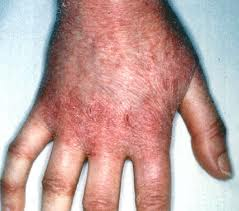 A. aka: housewives (househusbands) eczema, dishpan hands b. Most common cause of hand eczema (35% of cases) c. Etiology: excessive dryness leading to eczematous inflammation d. History: frequent hand washing, exposure to chemicals, previous eczema e. Clinically: dryness, chapping, fissures, itching f. Treatment: based on stage g. Prevention: decrease hand washes, moisturizers, avoid caustic chemicals and detergents, use mild soaps or non soap cleansers |
|
Atopic Hand Dermatitis
|
A. the most common presentation of atopic dermatitis in adults, and the second most common cause of
hand eczema (22%).
b. Think of
atopic dermatitis if hand eczema before age 15,
has eczema on the body, or history of “eczema” as a child
c. All of the
information on Irritant Contact Dermatitis of the
Hand is the same with atopic, except that this is the underlying predisposition
|
|
Allergic Contact Dermatitis
|
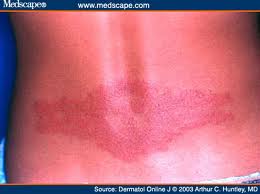 a. True allergic reaction causing hand dermatitis is the cause in 10% of cases. b. Etiology: Nickel (metal exposure), potassium dichromate (cement, leather), rubber (gloves), fragrances (cosmetics), formaldehyde (fabrics, paper, cosmetics) and lanolin (lubricants) c.) Clinically: may have distinct signs that is allergic (rash under jewelry), but in most cases presents as regular hand eczema d.) All of the information on Irritant Contact Dermatitis of the Hand is the same with Allergic Contact dermatitis, except to further investigate cause and remove from exposure once identified. |
|
Figertip Eczema
|
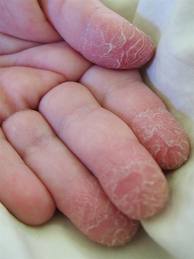 A. A variant of hand eczema, that stops just prior to the distal interphalangeal joint b. Resistance to standard treatment is seen, and will come and go for months to years |
|
Dyshidrotic Hand Eczema
|
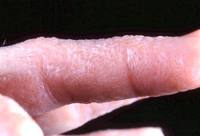 a. General info: A distinct hand eczema characterized by sweaty palms (and soles), itching, and vesicular eruptions b. Clinically: Tapioca like vesicles appear on sides of fingers, worsened by emotional stress c. Etiology: unknown, patients sweat 2.5 times more than normal d. Treatment: Topical steroids, cool compresses, oral antibiotics (if infected). Worse cases may require oral steroids. Decrease stress may also help. |
|
Asteatotic Eczema
|
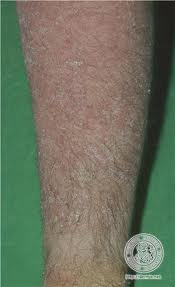 1. aka: eczema craquele 2. Etiology: excessive dryness leading to eczematous inflammation 3. History: previous eczema, underlying atopic state, winter exacerbation 4. Clinically: dryness, cracking, superficial fissures, lower legs; “cracked porcelain” appearance; pain rather than itching 5. Treatment: based on stage (acute, subacute, chronic) Topical steroids, cool compresses, oral antibiotics (if infected),and frequent moisterizing |
|
Nunmular Eczema
|
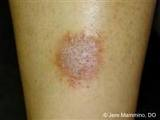 1. General: Coin shaped papules and plaques of eczema 2. History: middle aged patients, worse in winter, back of hand most common site, extremities 3. Clinically: erythematous, annular papules and plaques, can display vesicles, dryness, and scale; itching is moderate to severe 4. Treatment: based on stage (acute, subacute, chronic) Topical steroid, frequent moisturizing, and antihistamines |
|
Lichen Simplex Chronicus
|
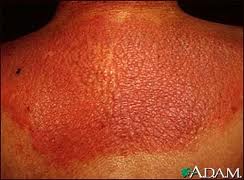 1. aka: neurodermatitis; chronic itchy spot 2. Etiology: excessive rubbing and scratching 3. History: previous eczema or itchy skin, subconscious rubbing 4. Clinically: Pruritic, erythematous and lichenified plaque(s), on lower leg, neck, scrotum, vulva. Can lead to true neurotic excoriations 5. Treatment: Topical steroids, antihistamines and frequent moisturizing |
|
Rhus Dermatisis
|
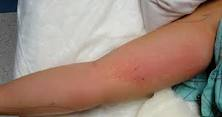 A. Allergen - resinous sap known as urushiol b. Cross reactions to cashew trees, mango tress, Japanese lacquer trees, and ginkgo c. Clinically: erythematous based vesicles in linear fashion, 8 hours to 1 week after exposure. Blister fluid does not spread the eruption. d. Treatment: Wash with soap to clear resin (should be done within 15 min of exposure). Cold compresses, high potency topical steroids, oral or intramuscular steroids for full 3-4 weeks, and antihistamines. |
|
Shoe Dermatitis
|
a.) Allergen - Mercaptobenzothiazole, a
rubber component of
adhesives used to cement shoe uppers, leached into skin due
to
perspiration
b.) Clinically: erythema and
dermatitis of feet, usually sparing
the interdigital space
c.) Treatment: Cold compresses,
high potency topical steroids,
oral
or intramuscular steroids for full 3-4 weeks, and
antihistamines. Control
perspiration
|
|
Metal Dermatitis
|
A.) Allergen -
Nickel, used as alloy in most jewelry; may even be
present in “hypoallergenic gold”
b.) Clinically: erythema and
dermatitis of earlobes, neck line,
abdomen, etc.
|
|
Atopy
|
1. A term given to patients with a history of hay fever,
asthma, dry skin and eczema
|
|
Diagnostic Criteria of Atopic Dermatitis
|
Major Features (must have 3 or more)
a. Pruritus
b. Typical
morphology and distribution
(Flexural lichenfication in
adults, Facial and extensor involvement
in infants and children)
c.
Dermatitis-chronically or chronically relapsing
d. Personal or family history of atopy-asthma,
allergic rhinitis atopic dermatitis Minor: (must have 3 or more)-> see book
|
|
Etiology/Pathophysiology of Atopic Dermatitis
|
1. Elevated T lymphocyte activation leading to an
overproduction
of IgE (80% of
patients have elevated IgE)
2. Defective cell mediated immunity with common
bacterial
infections
|
|
Clinically-Atopic Dermatitis
|
1. Infantile Atopic Dermatitis (birth
to 2 years):
a. Starts the
3rd month of life
b. Cheeks (perioral
sparing), trunk, extremities, spares diaper area
c. Resolves in
50% of infants by 18 months
2. Childhood Atopic Dermatitis:
a.) Flexural
involvement - antecubital fossae, neck,
wrists, ankles, popliteal fossae
b.) Persipirations of
opposing skin surfaces leads to increased pruritus and
initiates the itch scratch cycle
c.) Scratching
will lead to lichenfication
3. Adult Atopic Dermatitis:
a. Flexural
involvement, like childhood phase b. Hand
dermatitis
c. Periocular
dermatitis d. Lichenfication of the anogential area
|



